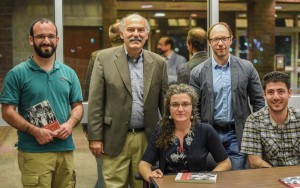
Photo: Hourig Attarian
Elina Karapetyan
Staff Writer
After the devastation of the Armenian Genocide in 1915, Armenians who remained inside the borders of Turkey were left to reconstruct their lives and identities amidst politically hostile conditions. Among the community’s most influential people were feminist women who “articulated an Armenianness sustained through gendered differences.”
The treatment of the remaining Armenians, their response to the Turkish regime, and feminism was the subject matter of a lecture by Dr. Lerna Ekmekçioğlu entitled “Survivors into Minorities: Armenians in Post-Genocide Turkey” presented on Monday, April 18th, sponsored by the Armenian Studies Program and with the support of the Leon S. Peters Foundation.
Dr. Ekmekçioğlu’s talk was based on the research for her book Recovering Armenia: The Limits of Belonging in Post-Genocide Turkey, which was released by Stanford University Press in early 2016.
Subsequent to World War I, the victorious Allied powers occupied Ottoman territories, and as a result, Armenian survivors returned to their hometowns in the hopes of establishing a sovereign Armenia. In her talk, Dr. Ekmekçioğlu, McMillan-Stewart Associate Professor of History at the Massachusetts Institute of Technology, explained how the Turkish Nationalist forces ultimately triumphed, and in response, by 1923 the Allies retreated from Turkish territory.
The Turkish Republic was founded in 1923 leaving Armenians once more to maintain their society and values in a country that characterized them as traitors. “Armenians already knew that what was happening to their community, to their nation at large, was a systematic and unprecedented attack,” said Dr. Ekmekçioğlu.
Armenians talk about survival and recovery through a familial language, and it was widely accepted that the institution of the family was to play a crucial role in national restoration.
“In a reversal of the former patrilineal rules,” said Dr. Ekmekçioğlu, “after the Genocide every baby born to an Armenian was considered a full fledged Armenian by the Armenian Patriarchate. It didn’t matter if the father was of Muslim descent.”
This emphasis on family life and the well being of children was a reflection of post-Genocide demographic anxiety; at this time, the Armenians were compensating after the war, by building strong families and having more children.
“By relying on their past and making good use of whatever freedoms they had, Armenians retained self governance within their community. They found a way to continue living and thriving in Turkey,” stated Dr. Ekmekçioğlu.
Women came to play an incredibly important role in the rebuilding of the Armenian nation.
Among many influential women, Hayganush Mark, was a prominent public figure who was a feminist, activist, and editor of the widely read and praised Hay Gin (Armenian Woman) journal. These women reinforced “Armenianness” that was carried out through gendered discrepancy. “
But even as women were being celebrated for their traditional roles, a strong feminist movement found opportunity for leadership within the community” said Dr. Ekmekçioğlu.
Dr. Ekmekçioğu’s research provided new insights into a period of Armenian history that has been under-studied.
 Hye Sharzhoom Armenian Action
Hye Sharzhoom Armenian Action